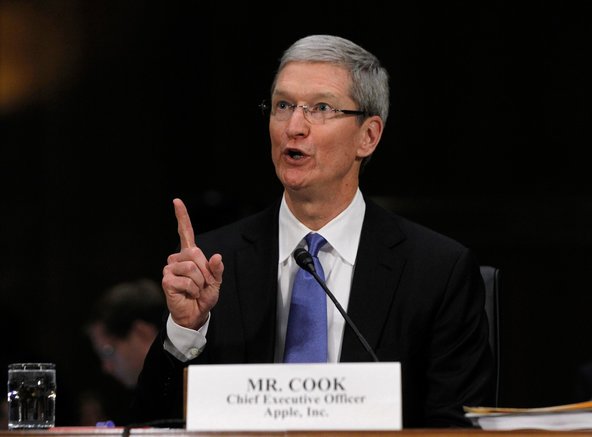 Jason Reed/ReutersSome have suggested that Timothy D. Cook’s calculation of Apple’s tax rate is based on a badly distorted measure of United States income.
Jason Reed/ReutersSome have suggested that Timothy D. Cook’s calculation of Apple’s tax rate is based on a badly distorted measure of United States income.
One lesson from the Senate hearing about Apple’s offshore tax planning is that figuring out what a multinational company actually pays in taxes is harder than it should be. At the risk of sounding Clintonesque, it depends on what the meaning of “pays” is.
“The way I look at this is that Apple pays 30.5 percent of its profits in taxes in the United States,” Apple’s chief executive, Timothy D. Cook, said at the hearing. The statutory rate for companies is 35 percent, and in theory the government taxes corporations on their worldwide income at that rate. Mr. Cook explained that Apple paid less on a global basis because its profits generated abroad were taxed at a lower rate than in the United States.
The way I arrive the real taxes paid by Apple is a little different. As Bloomberg News highlighted recently, Mr. Cook’s calculation is based on a badly distorted measure of United States income.
Standard Deduction
View all posts
The whole point of the Senate hearing was to show how Apple shifts substantial amounts of its economic profits from the United States to Ireland, where they are taxed at a rate close to zero. Those profits are then sheltered in Ireland and untaxed unless Apple decides to bring the cash back to the United States.
These overseas profits create deferred tax liabilities that will not be taxed until the cash is repatriated. But Apple is reluctant to repatriate its overseas cash; it would rather lobby for another tax holiday and bring the cash back tax-free. An added benefit of a tax holiday for Apple is that it would provide a quick jump in reported earnings when the accounting entry for the deferred tax liability is reversed.
My point is that politicians and voters are interested in a very different question than Apple’s shareholders. Shareholders are indifferent to whether a dollar of tax is paid to the Treasury Department or to a foreign government and credited in full by the American tax system. Either way, it’s a dollar that won’t be distributed to the shareholders.
But as voters we care about actual dollars flowing to the federal government. You can’t finance a food stamp program with foreign tax credits.
Most of us think of paying taxes as writing a check to the government or having money withheld from a paycheck. By this common sense measure, how much tax does Apple actually pay?
The number can be calculated from the company’s tax return, but tax returns are not public. Felix Salmon of Reuters has suggested that public companies file their tax returns with the Securities and Exchange Commission. The problem is that many companies would resist disclosing information that could offer competitors insight into company strategy, including tax avoidance strategies.
It’s sometimes possible to dig through a company’s filings and figure out the amount of cash paid in taxes, but accounting conventions make the task onerous and imprecise. It shouldn’t be this hard.
Here’s my suggestion. Congress should require every large American company to disclose to the public a simple number each year, which I would call the “true U.S. tax rate”: (1) the amount of cash tax payments to the Treasury Department divided by (2) worldwide pretax book income. To account for fluctuations, we might calculate this number over a three-year period.
According to the Senate report, Apple paid $5.3 billion to the Treasury Department in the fiscal years 2009 to 2011. Its worldwide pretax book income over that period was about $65 billion. Thus, Apple’s “true U.S. tax rate,” according to my own calculation, was 8.2 percent.
Companies might complain that this figure is deceptive, as it does not account for foreign taxes paid and credited in the United States, or book-tax differences like accelerated depreciation. But so what?
The point of the disclosure is to allow voters and policy makers an easy way to understand how well the tax system is working and what each corporation contributes to the public coffers.
Victor Fleischer is a professor at the University of Colorado Law School, where he teaches partnership tax, tax policy and deals. Twitter: @vicfleischer
This post has been revised to reflect the following correction:
Correction: June 4, 2013
An earlier version of this column referred incorrectly to Mr. Cook’s estimate of Apple’s 2012 tax liability. It does not include deferred tax liabilities. According to Mr. Cook’s written testimony, the estimate was based on “a reflection of federal taxes Apple paid against U.S. pretax earnings, not a calculation of Apple’s final tax liability for FY 2012.”
Article source: http://dealbook.nytimes.com/2013/06/04/calculating-apples-true-u-s-tax-rate/?partner=rss&emc=rss
